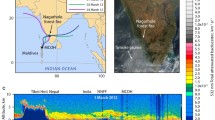Abstract
The purpose of this work is to investigate the influence of low air pressure on the smoke production and fractal structure properties of soot aerosols formed in fires. A series of experiments of n-heptane pool fires were conducted in a pressure chamber that could simulate ambient pressures from 40.4 kPa to 101 kPa. Soot aerosols were collected by carbon-supported copper grids and then examined by scanning electron microscopy to determine the soot morphology. A smoke meter was employed to detect the extinction coefficient of smoke in the chamber. The results indicate that the mean primary particle diameter, the mean number of primary particles per aggregate and the mean aggregate radius of gyration were reduced with decreasing air pressure. The Mueller matrix element S11 and extinction efficiency factor were calculated using the discrete dipole approximation method. For the soot formed at lower pressure, values of S11 of the overall scattering angles are much less than those formed under higher pressure. The scattering asymmetry factors indicate that forward scattering is dominant for soot particles of n-heptane pool fires. The ratio of forward scattering intensity to backward scattering intensity along with the extinction efficiency factor of single soot particle and the extinction coefficient of smoke decrease with decreasing pressure; the mean extinction coefficient of smoke is proportional to pressure to the power 3.3. These results may be useful for engineers to develop smoke detectors or other related technologies applied in cargo compartments or other regions under low pressure.















Similar content being viewed by others
References
Glassman I, Yetter R (2008) Combustion. Academic Press, Burlington. pp 1–41
Klusek C, Manickavasagam S, Mengüç MP (2003) Compendium of scattering matrix element profiles for soot agglomerates. J Quant Spectrosc Radiat Transf 79–80(0):839–859
Manickavasagam S, Mengüç M (1997) Scattering matrix elements of fractal-like soot agglomerates. Appl Opt 36(6):1337–1351
Fereres S, Lautenberger C, Fernandez-Pello C, Urban D, Ruff G (2011) Mass flux at ignition in reduced pressure environments. Combust Flame 158(7):1301–1306
Köylü ÜÖ, Faeth GM, Farias TL, Carvalho MG (1995) Fractal and projected structure properties of soot aggregates. Combust Flame 100(4):621–633
Köylü ÜÖ, Faeth GM (1992) Structure of overfire soot in buoyant turbulent diffusion flames at long residence times. Combust Flame 89(2):140–156
Sorensen C (2001) Light scattering by fractal aggregates:a review. Aerosol Sci Technol 35:648–687
Kim W, Sorensen CM, Fry D, Chakrabarti A (2006) Soot aggregates, superaggregates and gel-like networks in laminar diffusion flames. J Aerosol Sci 37(3):386–401
Wu Y, Gu X, Cheng T, Xie D, Yu T, Chen H, et al. (2012) The single scattering properties of the aerosol particles as aggregated spheres. J Quant Spectr Radiat Transf 113(12):1454–1466
Goo J (2012) Development of the size distribution of smoke particles in a compartment fire. Fire Saf J 47:46–53.
Dobbins RA, Megaridis CM (1987) Morphology of flame-generated soot as determined by thermophoretic sampling. Langmuir 3(2):254–259
Samson RJ, Mulholland GW, Gentry JW (1987) Structural analysis of soot agglomerates. Langmuir 3:272–281
Sorensen CM, Cai J, Lu N (1992) Light-scattering measurements of monomer size, monomers per aggregate, and fractal dimension for soot aggregates in flames. Appl Opt 31:6547–6557
Zhang HX, Sorensen CM, Ramer ER, Olivier BJ, Merklin JF (1988) In situ optical structure factor measurements of an aggregating soot aerosol. Langmuir 4:867–871
Mulholland GW, Mountain RD (1999) Coupled dipole calculation of extinction coefficient and polarization ratio for smoke agglomerates. Combust Flame 119(1):56–68
Chiti S (2015) A pilot study on hypoxic air performance in fire prevention. Fire Technol 51:393–407. doi:10.1007/s10694-014-0393-6
Li M, Lu S, Guo J, Chen R, Tsui K-L. (2014) Initial fuel temperature effects on flame spread over aviation kerosene in low- and high-altitude environments. Fire Technol 51:707–721. doi:10.1007/s10694-014-0395-4
Wieser D, Jauch P, Willi U (1997) The influence of high altitude on fire detector test fires. Fire Safety J 29(2–3):195–204
EM Puracell, CR Pennypacker (1973) Scattering and adsorption of light by nonspherical dielectric grains. Astrophys J 186:705–714
Draine BT, Flatau PJ (1994) Discrete-dipole approximation for scattering calculations. JOSA A 11(4):1491–1499
Draine B, Goodman J (1993) Beyond clausius-mossotti—wave-propagation on a polarizable point lattice and the discrete dipole approximation. Astrophys J 405:685–697
Draine BT (1988) The discrete-dipole approximation and its application to interstellar graphite grains. Astrophys J 333:848–872
Draine B, Flatau P (2013) User guide for the discrete dipole approximation code DDSCAT 7.3. http://arxiv.org/abs/1305.6497
LORENZ (2014) Manual obscuration-meter AML Firetestroom-Version
Shaddix CR, Smyth KC (1996) Laser-induced incandescence measurements of soot production in steady and flickering methane, propane, and ethylene diffusion flames. Combust Flame 107(4):418–452
KerKer M (1969) The scattering of light and other electromagnetic radiation. Academic Press, London
Dobbins RA, Megaridis CM (1991) Absorption and scattering of light by polydisperse aggregates. Appl Opt 33:30
Puri R, Richardson TF, Santoro RJ, Dobbins RA (1993) Aerosol dynamic processes of soot aggregates in a laminar ethene diffusion flame. Combust Flame 92(3):320–333
Author information
Authors and Affiliations
Corresponding author
Rights and permissions
About this article
Cite this article
Yang, S., Lu, S., Cheng, X. et al. Smoke Production and Fractal Structure Properties of Soot from n-Heptane Pool Fires Under Low Pressures. Fire Technol 52, 1915–1937 (2016). https://doi.org/10.1007/s10694-015-0526-6
Received:
Accepted:
Published:
Issue Date:
DOI: https://doi.org/10.1007/s10694-015-0526-6




